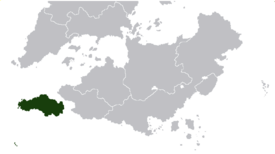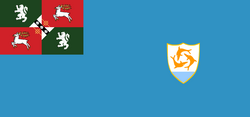Satavia
This article is incomplete because it is pending further input from participants, or it is a work-in-progress by one author. Please comment on this article's talk page to share your input, comments and questions. Note: To contribute to this article, you may need to seek help from the author(s) of this page. |
Republic of Satavia | |
|---|---|
| Anthem: All Earthly Things Above Alle aardse dingen hierboven | |
 Location of Satavia, in Green, in Asteria Inferior | |
| Capital and largest city | Port Hope |
| Official languages | Estmerish Hennish |
| Recognised national languages | Dupowek |
| Ethnic groups (2015) | |
| Demonym(s) | Satavian |
| Government | Parliamentary Republic |
• Governor | Arthur Livingstone-Scott |
| Jago Elliot | |
| Legislature | Parliament of Satavia |
| County Court | |
| Commoner's Court | |
| Establishment | |
• First Trade Posts set up by the South Asterian Company | 1548 |
• Colonisation by the Sotirian Commonwealth | 1649 |
• Transfer to Estmere | 1747 |
• Dissolution of Estmerish Asteria, and foundation of the Hope Territory | 1778 |
• Officialy becomes a colony, forming the Estmerish Hope Colony | 1782 |
• Home Rule Granted (Hope Colony Home Rule (Dominion) Act 1816) | 1816 |
• Decleration of Independence | 1st January, 1900 |
| Area | |
• Total | 663,130 km2 (256,040 sq mi) |
| Population | |
• 2018 estimate | 21,501,500 |
| GDP (nominal) | 2015 estimate |
• Total | $462.2 Billion |
• Per capita | $21,500 |
| Gini (2015) | medium |
| HDI (2015) | high |
| Currency | Satavian Guilders |
| Time zone | UTC+ 11 (Satavian Standard Time) |
| Date format | dd.mm.yyyy |
| Driving side | left |
| Calling code | +47 |
| Internet TLD | .sa |
Satavia, officially the Republic of Satavia (Hennish: Republiek Satavia), is an Island Nation in Western Asteria Inferior, and shares a Maritime Border with Nuvania. Satavia consists of the Satavian Isles and the Patrick Islands, an autonomus dependency of Satavia. The capital, largest city and biggest financial center is Port Hope, which had previously been known as Hope Town. Other major settlements include Porth Jago, Adamstown, Peterstad, Port Arthur, Millbrook and Degshaven.
Satavia was one of the last countries in the Asterias to gain independence, doing so in 1900. In a 2012 Referendum, 67.44% voted to restore the pre-republican flag of Satavia, and replace the Republican Flag.
Etymology
History
Pre-Historical
Colonisation Period
The First Hennish Republic and their South Asterian Company first established trade posts along the Satavian Coast in 1544, four years after both the Duchy of Flamia and the First Hennish Republic had established trade posts along the Nuvanian Coast. By 1548 at the earliest[1], the Duchy of Flamia, with their New Asterian Company, began colonising Satavia. However, in 1552, the Duchy abandoned their trade posts after a short, undeclared conflict which ended their involvement in Satavia. All of these trade posts are now uninhabited, with the majority having been destroyed or dismantled.
In 1649, the Sotirian Commonwealth officially took over the South Asterian Comapany's remaining trade posts. This saw a period of inactivity in Satavia, untill the Grand Duchy of Flamia was established in 1719, which heralded a change of administration and an influx of cheap labour, paticularly from Bahia. The Grand Duchy's conquering of Commonwealth settlements in Satavia and Nuvania saw the creation of Flamian Asteria.
Following the Estmerish-Hennish War, the colony was transfered to Estmere, who created Estmerish Asteria. This was disolved in 1778, creating instead Nuvania (a colony) and the Hope Teritory. This short-lived teritory would be succeeded by the Estmerish Hope, also called the Hope Colony in 1782. The Estmerish period would see a booming population and industry, a reason often attributed to Satavia's politicians reluctance to seek independence from Estmere, unlike their Nuvanian counterparts. The period also saw extensive Estmerisation, which saw the majority of the populace starting to speak Estmerish, as opposed to Hennish.
In 1811, Nuvania was granted home rule, to be followed by Satavia five years later in 1816, under the Hope Colony Home Rule (Dominion) Act 1816. The Estmerish Hope became the Hope Dominion, and in 1816 it's first Prime Minister, Richard Somerset, was appointed. The next sixty years would see a period of rapid growth and self sustainability, with Satavia beginning to trade with Nuvania more than Estmere. This would be shattered following the War of the Arucian, which Satavia was not involved in, but following Nuvania's victory and then decleration of independence would lead to a decline in trade with Satavia and the eventual economic crash in the form of the Satavian Recession of 1893. Estmere's lack of interest in helping the Dominion lead to Satavian leaders asking for independence. 1893 also saw the first Satavian Governor actually from Satavia, unlike previous Governors who had all been from Estmere. Following a series of bilateral talks with the Estmerish Government, and the rejection by Satavian leaders to be 'equal partners' with Estmere and Satavia sharing a Monarch, a deal was reached in that Satavia's Governor, a cousin of the King of Estmere, Patrick, would be made King Patrick I. On the 1st of January, 1900, Satavia became the last major colony in the Asterias to declare independence.
Kingdom of Satavia
• Patrick I Proclaimed King of Satavia
Great War
• Need to check Satavia's involvement (possibly prommised money?)
February Coup
Satavian Crisis
The Satavian Crisis was a period of sectarian political violence in Satavia that lasted from 1973 until 1983, with the Cease Fire and Normalisation of Civil Relations Act, 1983 which ended the government's state of emergency and saw an effective end to all fighting in Satavia. The collapse of the Second Bleum Government in 1976 lead to the establishment of a caretaker government lead by Arthur Elliot. Following the 1976 Republican Election, a non-Republican Party government was established, the first since 1935, which saw the end of the Satavian Republican Period and the re-classification of Satavia from an "effective one-party state" to a "multi-party parliamentary democracy" with the Community of Nations and the International Council for Democracy.
Initial violence erupted in 1973, following the introduction of the 1973 Satavian Constitutional Amendments which clamped down on anti-republican sentiment and was introduced by far-right Republican Party leader and Prime Minister Dick Bleum. Violence was started by the Free Satavian Army, who advocated for a return to "real democracy", with their attempted assasination of Bleum. Soon after, Monarchist Paramilitiaries began a campaign of terror.
Several attacks in 1976 lead to the complete collapse of the Republican Government, and the introduction of a caretaker governmnet.
Republic of Satavia (2nd Satavian Republic)
• Current Republic
Recent History
Geography
Climate
Politics
Government
Electoral System
Administrative Divisions
Military
Foreign Affairs & International Standing
- ↑ Sources vary on when the Duchy of Flamia began colonising Satavia, but the majority imply that it was around 1548



